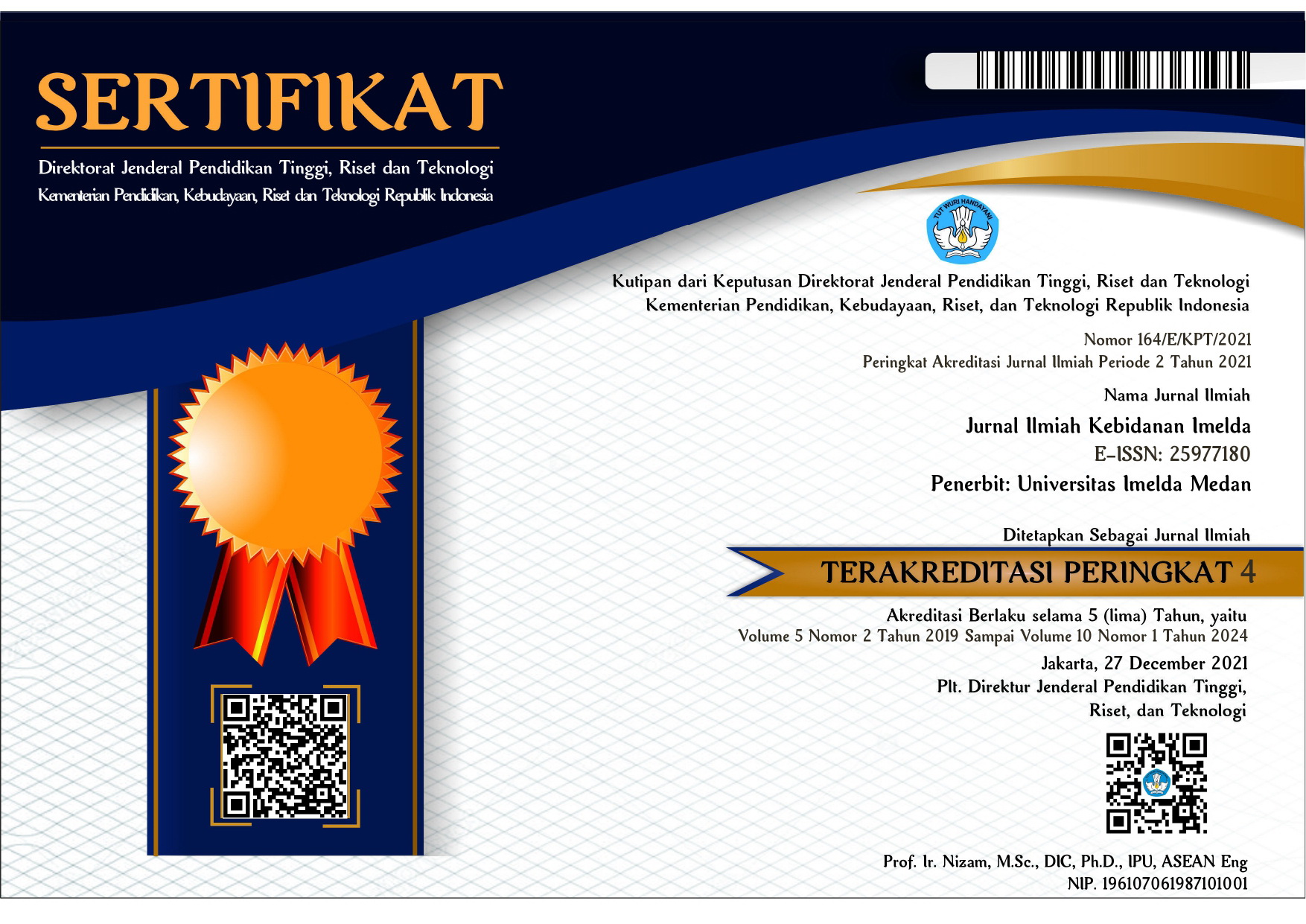STUDY MIXED METHODS PPNMSS (PERCEIVED PRENATAL MATERNAL STRESS SCALE) TERHADAP TINGKAT STRES IBU REMAJA DENGAN KTD (KEHAMILAN TIDAK DIINGINKAN)
DOI:
https://doi.org/10.52943/jikebi.v10i2.1754Keywords:
Teenage Mother, Pregnant Mother, Pregnant, Mental Health, StressAbstract
Teenage pregnancy is a global phenomenon with well-known causes and serious health, social and economic impacts. Globally, the Adolescent Birth Rate (ABR) is decreasing, but the rate of change is uneven across regions. Adolescent mothers (aged 10–19 years) face a higher risk of eclampsia, puerperal endometritis, and systemic infections than women aged 20–24 years, and infants of adolescent mothers face a higher risk of low birth weight, preterm birth, and neonatal emergencies. The purpose of this study was to analyze and explore the stress levels of adolescent mothers with PPNMSS in unintended pregnancies. The research method used was a mixed method with a Sequential Explanatory Design approach. The sample in this study was 45 adolescent pregnant women and those who were used as qualitative research informants were adolescent pregnant women who experienced severe stress. This study used a purposive sampling technique. Data collection using the PPNMSS questionnaire and in-depth interviews. Data analysis was carried out using univariate tests with the aim of describing the characteristics of informants and the stress levels of pregnant women. In the bivariate test with the chi square test through SPSS version 25 aims to see what is related to the stress level of pregnant women who are teenagers. While qualitative analysis can be done after finding pregnant teenage mothers with the highest scores who experience stress during pregnancy. The analysis used with thematic analysis with Nvivo 12 Plus software starting from data collection, data reduction, data display, verification and confirmation of conclusions (conclusion drawing and verification). The results of the study showed that pregnant women who were teenagers were mostly 19 years old (33.0%), the majority of junior high school education (42.0%), the majority of teenage mothers did not work (80.0%) and the majority experienced severe stress (29.0%). Based on the Pearson chi-square value (0.001; 0.024; 0.029) showed a relationship between age, education and work with the stress level of pregnant women who were teenagers. The research theme consists of factors causing Unwanted Pregnancy (KTD), coping strategies for Unwanted Pregnancy, the impact of Unwanted Pregnancy. Conclusion: High stress on unwanted pregnancy and high desire among adolescent couples to have abortion, highlight the need for coping strategies and information support from health workers, especially through social media promotion.
References
WHO, “Adolescent Pregnancy,” 2023. https://www.who.int/news-room/fact-sheets/detail/adolescent-pregnancy (accessed Jun. 02, 2023).
P. S. Gangadharan and S. P. K. Jena, “Development of perceived prenatal maternal stress scale.,” Indian J. Public Health, vol. 63, no. 3, pp. 209–214, 2019, doi: 10.4103/ijph.IJPH_29_18.
V. Silverwood et al., “Healthcare professionals’ perspectives on identifying and managing perinatal anxiety: A qualitative study,” Br. J. Gen. Pract., vol. 69, no. 688, pp. E768–E776, 2019, doi: 10.3399/bjgp19X706025.
P. S. Fauziah, H. Hamidah, and A. Subiyatin, “Kehamilan Tidak Diinginkan di Usia Remaja,” Muhammadiyah J. Midwifery, vol. 3, no. 2, p. 53, 2022, doi: 10.24853/myjm.3.2.53-62.
P. N. Ntshayintshayi, L. A. Sehularo, I. O. Mokgaola, and N. V Sepeng, “Exploring the psychosocial challenges faced by pregnant teenagers in Ditsobotla subdistrict.,” Heal. SA = SA Gesondheid, vol. 27, p. 1880, 2022, doi: 10.4102/hsag.v27i0.1880.
Y. Wu et al., “Perinatal depressive and anxiety symptoms of pregnant women during the coronavirus disease 2019 outbreak in China.,” Am. J. Obstet. Gynecol., vol. 223, no. 2, pp. 240.e1-240.e9, Aug. 2020, doi: 10.1016/j.ajog.2020.05.009.
D. N. Pramudianti, Z. Fathony, and B. Ulfa, “Edukasi melalui pendidikan kesehatan pada ibu hamil tentang pencegahan depresi postpartum,” J. Masy. Mandiri, vol. 4, no. 4, pp. 6–9, 2020.
T. Tantu, S. Wolka, M. Gunta, M. Teshome, H. Mohammed, and B. Duko, “Prevalence and determinants of gender-based violence among high school female students in Wolaita Sodo, Ethiopia: an institutionally based cross-sectional study.,” BMC Public Health, vol. 20, no. 1, p. 540, Apr. 2020, doi: 10.1186/s12889-020-08593-w.
W. B. Sebayang and G. Saragih, “Pengaruh edukasi seksual terhadap perilaku seks pranikah pada generasi milenial,” JHeS (Journal Heal. Stud., vol. 4, no. 1, pp. 24–29, 2020, doi: 10.31101/jhes.1038.
F. Vahidi, M. Mirghafourvand, E. Naseri, and S. Ghanbari-Homaie, “Birth-related posttraumatic stress disorder and negative childbirth experience related to maternal functioning among adolescent mothers: a cross-sectional study.,” BMC Pregnancy Childbirth, vol. 23, no. 1, p. 371, May 2023, doi: 10.1186/s12884-023-05717-z.
R. T. Gultom, Y. Simbolon, and H. Sitanggang, “Hubungan Dukungan Emosional Bidan terhadap Tingkat Kecemasan Ibu Primigravida dalam Proses Kala I di RSU Imelda Pekerja Indonesia Medan Tahun 2023,” vol. 2, no. 1, pp. 52–61, 2024.
Masrizal, “Mixed Method Research,” J. Kesehat. Masy. Andalas, vol. Vol 6, No, pp. 53–56, 2021.
P. S. Gangadharan and S. P. K. Jena, “Development of Perceived Prenatal Maternal Stress Scale,” Indian J. Public Health, vol. 63, no. 3, 2019, doi: 10.4103/ijph.IJPH.
M. Hajizadeh and S. Nghiem, “Does unwanted pregnancy lead to adverse health and healthcare utilization for mother and child? Evidence from low- and middle-income countries.,” Int. J. Public Health, vol. 65, no. 4, pp. 457–468, May 2020, doi: 10.1007/s00038-020-01358-7.
B. G. Everett, S. Mollborn, V. Jenkins, A. Limburg, and L. M. Diamond, “Racial/Ethnic Differences in Unwanted Pregnancy: Moderation by Sexual Orientation.,” J. Marriage Fam., vol. 82, no. 4, pp. 1234–1249, Aug. 2020, doi: 10.1111/jomf.12656.
W. Ayalew Tegegne, “The Prevalence and Causes of Unwanted Pregnancy Among Woldia University Undergraduate Female Students: Implications for Psychosocial Intervention.,” Community Heal. equity Res. policy, vol. 42, no. 2, pp. 189–193, Jan. 2022, doi: 10.1177/0272684X20972840.
I. Mogotsi and P. Mwetulundila, “Understanding unwanted pregnancy from the perspectives of the Namibian male youth.,” Afr. J. Reprod. Health, vol. 24, no. 3, pp. 41–50, Sep. 2020, doi: 10.29063/ajrh2020/v24i3.5.
O. Sarı, B. F. Dağcıoğlu, Y. K. Akpak, N. Yerebatmaz, and A. İleri, “Planned and unplanned pregnancy and its association with coping styles and life quality.,” Health Care Women Int., vol. 44, no. 10–11, pp. 1314–1324, 2023, doi: 10.1080/07399332.2021.1932895.
A. L. Rodriguez, J. Arcara, J. Deardorff, and A. M. Gomez, “The association between religiosity and pregnancy acceptability among Latino/a young adults: does generational status matter?,” Cult. Health Sex., vol. 22, no. 2, pp. 184–200, Feb. 2020, doi: 10.1080/13691058.2019.1581260.
K. Sayehmiri, F. Ebtekar, M. Zarei, and R. G. Gheshlagh, “Prevalence of unwanted pregnancy among Iranian women: an updated meta-analysis.,” BMC Pregnancy Childbirth, vol. 19, no. 1, p. 491, Dec. 2019, doi: 10.1186/s12884-019-2640-9.
S. N. Shahrokhi, H. Salmani, and M. Ahmadi, “The Role of Electronic Health Tools in Unwanted Pregnancy Prevention, Abortion and Post-Abortion Follow-Up: A Systematic Review.,” Iran. J. Nurs. Midwifery Res., vol. 28, no. 5, pp. 487–503, 2023, doi: 10.4103/ijnmr.ijnmr_312_20.
S. Z. Jafari, M. Hajifoghaha, S. Azima, P. G. Maghami, and Z. Y. Panahi, “Investigating depression, anxiety, perceived stress and resilience in fathers faced with their spouse’s abortion in Iran: a longitudinal study.,” BMC Psychiatry, vol. 24, no. 1, p. 496, Jul. 2024, doi: 10.1186/s12888-024-05887-w.










